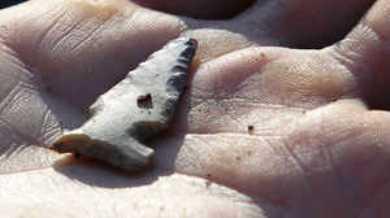Artifacts found at metro-east site might solve prehistoric mystery: Where did everyone go?
George Pawlaczyk
Source - : http://www.bnd.com/2011/09/05/1847284/local-artifacts-might-solve-prehistoric.html#ixzz1XC58ltky
The largest excavation of a prehistoric site in the country is poised to solve a riddle about Illinois prehistory that has lingered for a century -- where did the Mississippians go?
And why?

Overall of the excavation site, in the background is trackhoes and other excavation work related to the future Mississippi River Bridge. - Derik Holtmann/BND
An enormous dig of a village site first inhabited about 1050 A.D. on 78 acres of what used to be the National Stockyards is providing so much data and so many artifacts that archaeologists are daring to speculate that basic questions about the Mississippians will finally be answered.

An arrow point found at the dig site. - Derik Holtmann/BND
The Mississippians, or Native Americans, whose pottery and building styles identify them as a single cultural group, lived in or near the Mississippi Valley more than 1,000 years ago. They erected complex cities, built enormous mounds for ritualistic purposes and disappeared in the space of about 200-300 years.
But the stockyards dig, known as the "East St. Louis site," was abandoned after only 150 years.
This site is 5 miles west of the region's main group of mounds, now the grounds of the Cahokia Mounds State Historic Site in Collinsville, which was occupied for about another 150 years. However, less than 1 percent of the Cahokia Mounds site has been excavated because of a policy that the area should be reserved for future study.

Patrick Durst points to some of the unique features in the excavation site. - Derik Holtmann/BND
But the village site will be fully excavated.
"By 1200, the Mississippians are gone from this site with no evidence of any other occupation," said archaeologist Patrick Durst about the dig at the old stockyards. Durst, of the Prairie Research Institute of the University of Illinois at Champaign, supervises 90 hired diggers.
"What happened to them is one of the research questions we're hoping to answer. Having an opportunity to completely investigate a major portion of a site this large is almost unheard of. When we are finished with this project more of the East St. Louis mound group and the complex associated with it will have been excavated than all of Cahokia."
One of the questions is whether the people who lived in the East St. Louis village site were the same people who lived at the much larger Cahokia Mounds site.
"We're trying to identify how this community, and its large mound center, relates to Cahokia, the largest mound center," Durst said, "We don't know exactly the direct relationships between these groups. It could be different groups that didn't necessarily work together. We don't necessarily think they were enemies, but they may not be the exact same cultural groups."

A jar rim showing the effigy of a salamander. This large vessel was probably a ceremonial item. - Provided/BND
PART.2